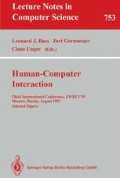Abstract
It is now widely recognized that powerful architecture elements are needed for implementing highly-interactive business-oriented applications during at least two stages of the whole lifecycle, namely the specification and the design. In this paper, we deal with the architecture model of the TRIDENT project, which introduces three components: the semantic core component, the dialog component and the presentation component. This is a hierarchical object-oriented architecture relying on the use of three kinds of objects: application objects, dialog objects, and interaction objects. Specification and rule languages are given for developing the dialog component. An abstract data model is used for characterizing the application objects. Selection rules are given for choosing appropriate interaction objects for the presentation component according to the abstract data model and to the user level.
Preview
Unable to display preview. Download preview PDF.
References
D. de Baar, J.D., Foley, K.E. Mullet: Coupling Application Design and User Interface Design. In P. Bauersfled, J. Bennett, G. Lynch (eds.): Proceedings of CHT92 (Monterey, May 1992). Reading: Addison-Wesley 1992, pp. 259–266
L. Bass, J. Coutaz: Developing Software for the User Interface. Series in Software Engineering. Reading: Addison-Wesley 1991
F. Bodart, J. Vanderdonckt: Expressing Guidelines into an Ergonomical Style-Guide for Highly Interactive Applications. In S. Ashlund, K. Mullet, A. Henderson, E. Hollnagel, T. White (eds.): Adjunct Proceedings of InterCHI'93 (Amsterdam, 24–29 April 1993), New York: ACM Press 1993, pp. 35–36
S.K. Card, T.P. Moran, A. Newell: The Psychology of Human-Computer Interaction. Hillsdale: Lawrence Erlbaum Assoc., 1985
J. Coutaz: PAC: an Implementation Model for Dialog Design. In H.-J. Bullinger, B. Shakel (eds.): Proceedings of Interact'87 (Stuttgart, Sept. 1987). Amsterdam: North Holland 1987, pp. 431–436
I. Greif: The User Interface of a Personal Calendar Program. In Y. Vassiliou (ed.): Human Factors and Interactive Computer Systems, NYU Symposium on User Interfaces Proceedings (New York, 26–28 May 1982). Series in Human/-Computer Interaction. Norwood, Ablex Publishing Corp. 1984, pp. 207–222
W.K. Horton: Designing & Writing On line Documentation — Help files to Hypertext. Chichester: John Wiley & Sons 1991
IBM Systems Application Architecture, Common User Access: Advanced Interface Design Guide. Document SC26-4582-0. Boca Raton: International Business Machines (June 1989)
IBM Systems Application Architecture: Basic Interface Design Guide. Document SC26-4583-0. Cary: International Business Machines (December 1989)
W. Kim, J.D. Foley: DON: User Interface Presentation Design Assistant. In Proceedings of the UIST'90 Conference (Snowbird, October 1990). New York: ACM press 1990, pp. 10–20
S. Kobara, Visual Design with OSF/Motif. Hewlett-Packard Press Series. Reading: Addison-Wesley 1991
J. A. Larson: Interactive Software — Tools for Building Interactive User Interfaces. Yourdon Press Computing Series. Englewood Cliffs: Prentice Hall, 1992
G.A. Miller: The Magical Number Seven, Plus or Minus Two: Some Limits on Our Capacity for Processing Information. Psychological Science 63, 81–97 (1956)
Z. Mills, M. Prime: Are All Menus the Same? — An Empirical Study. In D. Diaper, D. Gilmore, G. Cockton, B. Shackel (eds.): Proceedings of Interact'90 (Cambridge, 27–31 August 1990). Amsterdam: Elsevier Science Publishers 1990, pp. 423–427
P. Muter, C. Mayson: The Role of Graphics in Item Selection from Menus. Behaviour and Information Technology 5, 89–95 (1986)
Open Software Foundation. OSF/Motif™ Style Guide, rev 1.0. Englewood Cliffs: Prentice Hall, 1990
B. Sacré, I. Provot: Vers une approche orientée objet de la modélisation du dialogue d'une application de gestion hautement interactive [Towards an objectoriented approach for modelizing dialog in business-oriented highly interactive application]. Fac. Univ. N.-D. de la Paix, Institute of Computer Science. Internal report (October 1990)
B. Sacré, I. Provot: Proposition d'un langage de spécification de l'interface homme-machine d'une application de gestion hautement interactive [A Proposition for specification language dedicated to the man-machine interface of business-oriented highly interactive application]. Fac. Univ. N.-D. de la Paix, Institute of Computer Science. Internal report (December 1991)
P. Sukaviriya, J.D. Foley, T. Griffith: A Second Generation User Interface Design Environment: The Model and The Runtime Architecture. In: S. Ashlund, K. Mullet, A. Henderson, E. Hollnagel, T. White (eds.): Proceedings of the Conference on Human Factors in Computing Systems InterCHI'93 “Bridges Between Worlds” (Amsterdam, 24–29 April 1993). New York: ACM Press 1993, pp. 375–382
D.L. Scapin: Guidelines for User Interface Design: Knowledge Collection and Organization. Report ITHACA.INRIA.89.D12.03. Rocquencourt: Institut National de Recherche en Informatique et en Automatique, 30 December 1989
B. Shneiderman: Designing the user interface: strategies for effective humancomputer interaction. Reading: Addison-Wesley 1987
S.L. Smith, J.N. Mosier: Design guidelines for the user interface software. Technical Report ESD-TR-86-278 (NTIS No. AD A177198). Hanscom Air Force Base: U.S. Air Force Electronic Systems Division 1986
B. Tognazzini: The Apple//Human interface guidelines. Cupertino: Apple Computer 1985
T. S. Tullis: Designing a Menu-Based Interface to an Operating System. In L. Borman, B. Curtis (eds.): Proceedings of CHI'85 (San Francisco, 14–18 April 1985). New York: ACM Press 1985, pp. 79–84
UIMS Workshop Tool Developers: A Metamodel for the Runtime Architecture of An Interactive System. SIGCHI Bulletin, 24, 1, 32–37 (January 1992)
J. Vanderdonckt: Prise en compte des facteurs ergonomiques dans la conception des interfaces homme-machine. In M. Adiba, F. Bodart, M. Léonard, Y. Pigneur (eds.): Actes des journées de travail de Beaune '91 (Beaune, 5–7 March 1991). Genève: Les Editions Systèmes et Information 1991
J. Vanderdonckt, F. Bodart: Encapsulating Knowledge for Intelligent Automatic Interaction Objects Selection. In: S. Ashlund, K. Mullet, A. Henderson, E. Hollnagel, T. White (eds.): Proceedings of the Conference on Human Factors in Computing Systems InterCHI'93 “Bridges Between Worlds” (Amsterdam, 24–29 April 1993). New York: ACM Press 1993, pp. 424–429
Author information
Authors and Affiliations
Editor information
Rights and permissions
Copyright information
© 1993 Springer-Verlag Berlin Heidelberg
About this paper
Cite this paper
Bodart, F., Hennebert, A.M., Leheureux, J.M., Sacré, I., Vanderdonckt, J. (1993). Architecture elements for highly-interactive business-oriented applications. In: Bass, L.J., Gornostaev, J., Unger, C. (eds) Human-Computer Interaction. EWHCI 1993. Lecture Notes in Computer Science, vol 753. Springer, Berlin, Heidelberg. https://doi.org/10.1007/3-540-57433-6_41
Download citation
DOI: https://doi.org/10.1007/3-540-57433-6_41
Published:
Publisher Name: Springer, Berlin, Heidelberg
Print ISBN: 978-3-540-57433-0
Online ISBN: 978-3-540-48152-2
eBook Packages: Springer Book Archive

